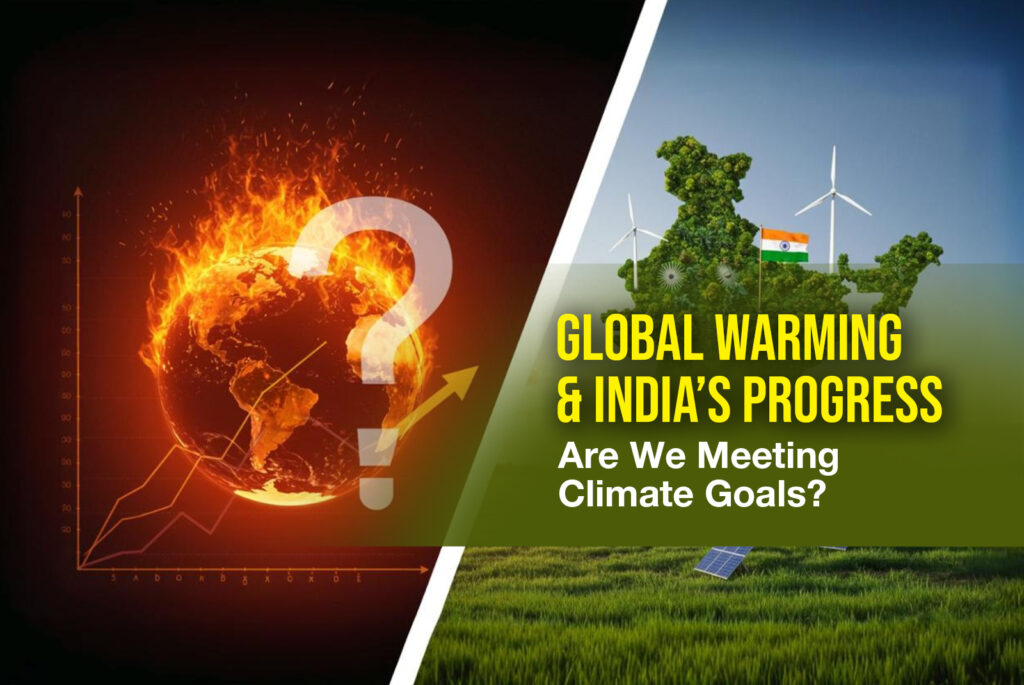Global warming is no longer a distant threat—it’s here, affecting our daily lives. From rising temperatures to unpredictable weather patterns, the consequences are becoming harder to ignore. For a country like India, where 1.4 billion people rely on stable weather for agriculture, energy, and daily life, tackling climate change is not just important—it’s essential.
India has taken bold steps toward reducing emissions, transitioning to renewable energy, and committing to ambitious climate targets. But are we doing enough? Are we on track to meet our goals? Let’s take a closer look.
India’s Climate Commitments: Big Promises, Bigger Challenges
In 2021, at the COP26 Climate Summit, Prime Minister Narendra Modi made five major commitments—what he called the Panchamrit (five nectar elements) strategy. These commitments are shaping India’s climate action plan for the next few decades:
- Achieve 500 GW of non-fossil fuel energy capacity by 2030.
- Meet 50% of electricity needs from renewables by 2030.
- Reduce carbon emissions by 1 billion tonnes by 2030.
- Lower the carbon intensity of GDP by 45% by 2030.
- Achieve net zero carbon emissions by 2070.
These targets are ambitious, and India has made significant progress in some areas. But challenges remain.
Where Does India Stand Today?
1. Renewable Energy: A Bright Spot in Climate Action
India’s renewable energy sector has expanded rapidly in the last decade. Today, the country has an installed capacity of 179 GW of renewable energy, with a strong focus on solar and wind power.
- Solar power capacity has reached 72 GW, making India one of the top five solar power producers in the world.
- Wind energy stands at 45 GW, primarily in states like Tamil Nadu, Gujarat, and Maharashtra.
- With continued investments, India is on track to meet its 500 GW non-fossil fuel target by 2030.
This is a huge achievement, but is it enough to curb the effects of global warming?
2. Rising Temperatures & Extreme Weather Events
Despite India’s push for clean energy, the effects of climate change are becoming more severe:
- Record-breaking heatwaves in 2023 and 2024, with some regions crossing 50°C, making daily life unbearable.
- Unprecedented floods in cities like Mumbai, Bengaluru, and Chennai, disrupting businesses and infrastructure.
- Glacial melting in the Himalayas, increasing the risk of water shortages and flash floods.
These extreme weather patterns highlight the urgent need for faster action. While renewable energy growth is promising, India still depends heavily on coal, which contributes to climate change.
3. The Coal Dilemma: Still a Major Polluter
Coal remains the largest source of electricity in India, despite the government’s efforts to promote clean energy.
- Over 50% of India’s electricity still comes from coal-fired power plants.
- India is the world’s second-largest coal consumer, making a rapid transition to clean energy difficult.
- Shutting down coal plants too quickly could lead to economic instability and job losses in coal-dependent states like Jharkhand and Chhattisgarh.
While India is investing in renewable energy, finding a way to gradually reduce coal dependency without harming the economy is one of its biggest challenges.
Key Challenges in Meeting Climate Goals
1. Growing Energy Demand
India’s economy is expanding rapidly, and with it, energy demand is skyrocketing. While renewables are increasing, they haven’t yet replaced fossil fuels at the scale needed.
2. Financing Green Energy Projects
The cost of shifting to clean energy requires massive investment. While the government is providing incentives, private investment and foreign funding need to increase to support long-term projects.
3. Policy Inconsistencies & Implementation Gaps
- Different states have different energy policies, creating confusion for investors.
- Land acquisition issues delay large-scale solar and wind projects.
- Bureaucratic red tape slows down the implementation of clean energy initiatives.
Without clear and consistent policies, achieving long-term climate goals will be difficult.
The Road Ahead: What India Needs to Do
To keep up with climate targets, India must accelerate its transition to green energy. Here’s how:
1. Expand Solar & Wind Power Faster
- Increase investments in solar and wind farms to reduce coal dependency.
- Develop offshore wind energy and floating solar farms to maximize space usage.
2. Improve Energy Storage & Grid Infrastructure
- Develop advanced battery storage solutions to make renewable energy available 24/7.
- Upgrade power grids to handle large-scale renewable energy integration.
3. Transition Coal Workers to Green Jobs
- Slowly phase down coal plants, instead of shutting them down overnight.
- Train coal sector workers for jobs in the renewable energy industry to prevent job losses.
4. Boost Green Hydrogen & Carbon Capture Technologies
- Green hydrogen can replace fossil fuels in industries like steel and transportation.
- Carbon capture technology can reduce emissions from factories and other polluting industries.
5. Strengthen Public & Private Investment in Clean Energy
- India needs better incentives for businesses to adopt renewable energy.
- Encouraging public-private partnerships will accelerate large-scale clean energy projects.
The Verdict: Is India on Track?
India has made huge strides in renewable energy, but the challenges of coal dependency, rising emissions, and climate adaptation remain. While investments in solar, wind, and green hydrogen are growing, policy execution, financing, and infrastructure improvements must speed up.
The next decade will be critical in determining how effectively India can balance economic growth with environmental sustainability. If the country can successfully scale up renewables, phase down coal, and modernize its grid, it has the potential to lead the global fight against climate change.
The question now is: Can India act fast enough to prevent the worst impacts of global warming?

